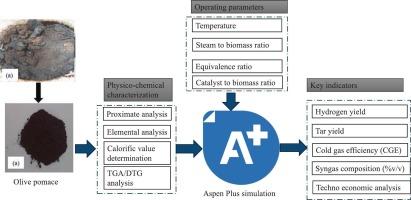橄榄渣生物废弃物催化蒸汽气化强化制氢研究
Q1 Environmental Science
引用次数: 0
摘要
橄榄渣(OP)是摩洛哥的一种主要生物废物,以非环境友好的方式被丢弃。利用这种潜力作为生物能源可以促进循环经济。在生物质利用的各种选择中,气化是最可行的途径,因为它具有环境优势。然而,低氢气产量和高焦油和二氧化碳排放是生物质气化的重大挑战。本研究使用Aspen plus®商业软件开发橄榄渣催化蒸汽气化。通过改变反应温度、蒸汽与生物质比、当量比和草与生物质比对体系进行了评价。模拟结果表明,蒸汽与CaO催化剂的协同作用可能催化挥发性裂化和CO2吸收,推动蒸汽重整和水煤气转移反应向前发展,从而提高H2产率。经济结果支持OP气化的可行性,投资回收期为2.43年,每吨OP的净利润为257.88美元。本文章由计算机程序翻译,如有差异,请以英文原文为准。

Catalytic steam-gasification of olive pomace biowaste for enhanced hydrogen production
Olive pomace (OP), a major biowaste in Morocco, is discarded in a non-environmentally-friendly manner. Harnessing this potential as a bioenergy source fosters a circular economy. Among the various options for biomass utilization, gasification is the most viable pathway because of its environmental advantages. However, low hydrogen yields and high tar and CO2 emissions are significant challenges in biomass gasification. This study used Aspen plus® commercial software to develop olive pomace catalytic steam gasification. The system was evaluated by varying the reaction temperature, steam-to-biomass ratio, equivalent ratio, and CaO-to-biomass ratio. The simulation results demonstrated that the synergetic effect of steam and the CaO catalyst likely catalyzes volatile cracking and CO2 absorption, driving steam reforming and water gas shift reactions forward, thus increasing the H2 yield. The economic results support the viability of OP gasification, with a 2.43-year payback period and a net profit of $257.88 per ton of OP.
求助全文
通过发布文献求助,成功后即可免费获取论文全文。
去求助
来源期刊

Bioresource Technology Reports
Environmental Science-Environmental Engineering
CiteScore
7.20
自引率
0.00%
发文量
390
审稿时长
28 days
 求助内容:
求助内容: 应助结果提醒方式:
应助结果提醒方式:


